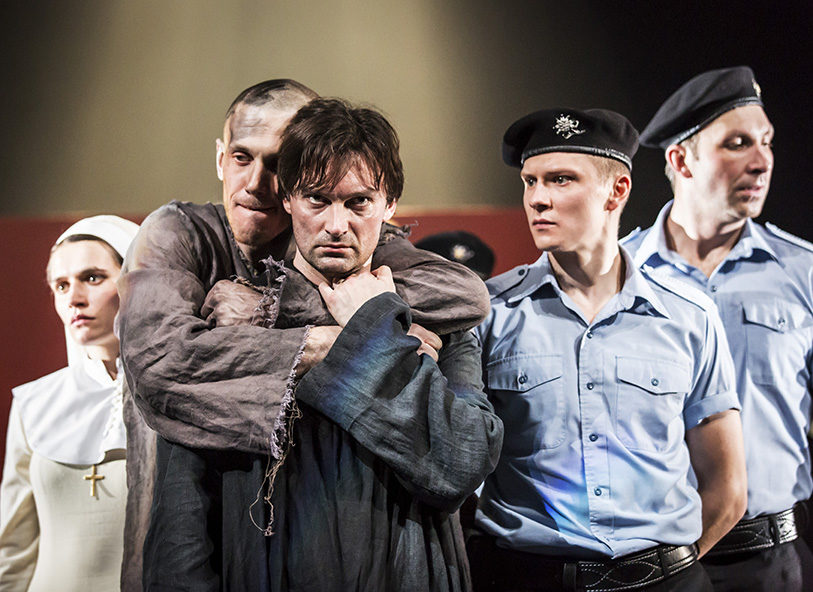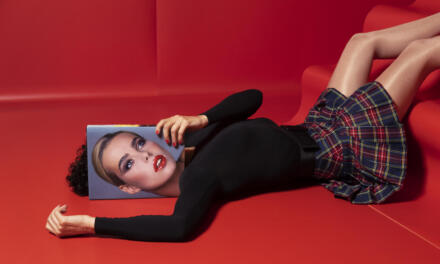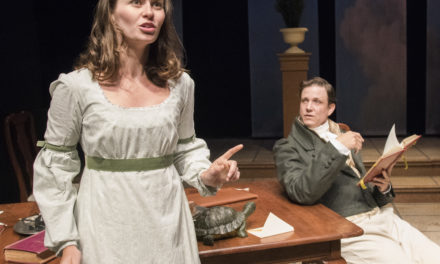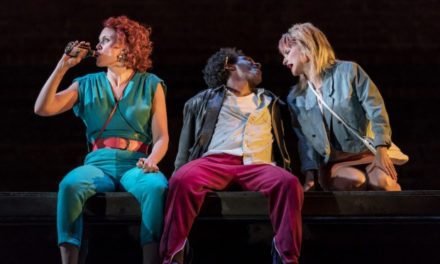Authority. Surveillance. Enforcement. Confession.
These are the tools of the state brought to life in Cheek by Jowl and The Pushkin Theatre’s production of Measure For Measure. In Declan Donnellan’s production, Isabella (Anna Vardevanian) becomes the battleground between individual agency and state authority, where other characters, including her brother Claudio (Petr Rykov) and power-hungry and bloodthirsty bureaucrat judge Angelo (Andrei Kuzichev), are differing assertions of the same system of power. The production asks that audience see Isabella, clothed in a nun’s habit, as a woman punished for her non-state allegiance, surrounded by both Ormerod’s design and Donnellan’s interpretation of the text which emphasize ideology, bureaucratic authority, and surveillance. The final villain of the piece then becomes the ultimate embodiment of state power: the Duke (Alexander Arsentyev).
Nick Ormerod’s design consists of five red cubes on a bare black stage. A large cluster of low-hanging interrogation-room lights, bulbs visible, conspicuously overhang the playing space. There is very little stage not visible to the audience, who the actors continually reference to emphasize that their awareness of constant scrutiny. Ormerod’s design offers only two colors: first the red of ideology (red books, red hats) that colors the five towers, a red carpet for the Duke’s final scene, and the folder containing the orders for Claudio’s death. Second, there is the blue of enforcement, which colors the uniforms of the security officers. The remaining design is various shades of black, dark brown, and grey, save for Isabella’s pure white nun habit, socks, and sneakers. The neutrals become the drudgery of bureaucracy, where the suit and glasses-wearing Angelo is a smaller, unassuming Judge who is able to enact violence because he controls the machinery of the state.
The production begins with the actors flocking together across the stage, blindly following each other until one steps out. This mass of actors remains onstage for the entirety of the production, with individuals stepping out to perform scenes while the remainder of the cast watches from various vantage points. This literalizes spectatorship, already forcing the audience to reflect on their own surveillance – and its implied complicity, as the actors point and look to the house during scenes. The engagement of the audience as a part of the production reaches a peak during the final scene when the Duke, standing at the end of a red carpet in front of a standing microphone as cheers play through the sound system, address the audience as a dictator would the masses.
The final scene emphasizes the demagoguery of the Duke, who has been present for Isabella’s torture throughout the production. Donnellan stages many comedic portions of the show through the Duke, who bumbles to fulfill his disguise as a friar. What these comedic moments demonstrate is that though the impenetrable juggernaut of Angelo’s authority (given by the Duke) is life and death for Isabella and Claudio, the Duke as Friar is playing a game–killing other prisoners, one of whom Donnellan has staged being hosed down naked on the stage by a security officer, to save Claudio. For the Duke, the systems of enforcement are a sport, and the production sprinkles these comedic moments throughout the piece, which add complexity to an otherwise tense and dark narrative (this is not a tragedy). When he too attempts to court Isabella in the final moments of the show, it becomes clear that the system which has violated Isabella is still in place, even if the principle enactor of violence, Angelo, was purged. Donnellan stages this scene alongside Claudio and Juliet holding their newborn child–emphasizing the system’s futurity.
The production also embodies systems of power through its staging of objects, brilliantly brought to life through Irina Kashuba’s choreography. At one point the ensemble carries Angelo’s brown, minimalist desk and chair onto the stage with elaborate choreography. Angelo ducks underneath to “balance” the table on his finger while two ensemble members rotate it. A bright red folder actualizes Claudio’s death warrant, which Isabella slides off the desk to the ground–the object standing in for the critical act. At another point when Angelo lusts after Isabella, he focuses his attention on the chair in which she has just sat, placing himself on the ground next to it, holding on, and at one point putting his face onto the seat. When these objects gain life it emphasizes the synthetic perpetuity of systems of power, even as the violence they inflict is human. The desk and warrant are culpable in Claudio’s death, regardless of who sits behind and signs.
The show was less well attuned in its staging of violence against Isabella, who is assaulted onstage by not only Angelo, but her brother Claudio in two sequences staged back-to-back, first when Angelo asks for her virginity in exchange for Claudio’s life, then after Claudio pleads with her to give in. In this reading, the violence against Isabella serves to link these two requests–where in both she is asked to give agency over her body to an authoritative man. Yet in staging this literalized violence not only where it occurs in the text, but in another choreographed sequence with Claudio, the show runs the risk of revivifying violence. Rather than staging a system of power or critiquing the parallels to the present, the show reasserts the consequences, giving the system new life. Furthermore, if part of the aim of this production was to bring out a search for the feminine agency in opposition to state hegemony, is Measure For Measure the best text to do so? Would it not be better to stage a work by a femme playwright rather than rework a Shakespearean one? While the character of Isabella invokes a long history of stagings, certainly that history is also one that has at many points served the state powers that the show seems to critique.
Overall, however, this piece is engaging and thought-provoking, featuring strong performances (particularly by Vardevanian) and ensemble work. In a contemporary moment of cross-cultural re-assertions of demagoguery and state power, this production of Measure For Measure makes an important intervention. The production raises questions surrounding the relationship between the state and the individual, laying bare power in which the audience is made actively and constantly complicit.
This post was written by the author in their personal capacity.The opinions expressed in this article are the author’s own and do not reflect the view of The Theatre Times, their staff or collaborators.
This post was written by Harry Hoke.
The views expressed here belong to the author and do not necessarily reflect our views and opinions.


















